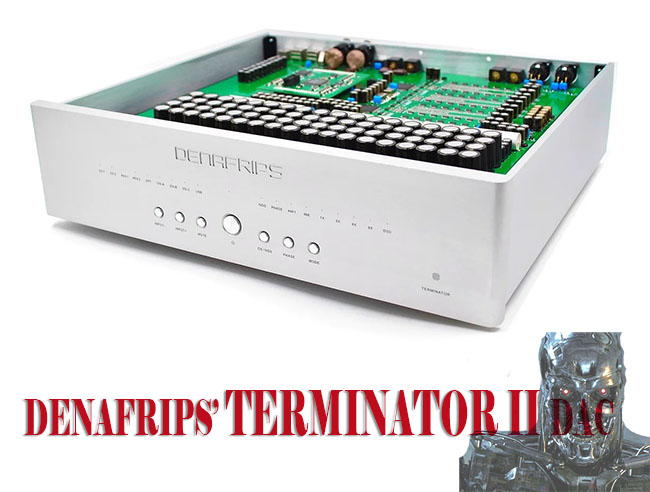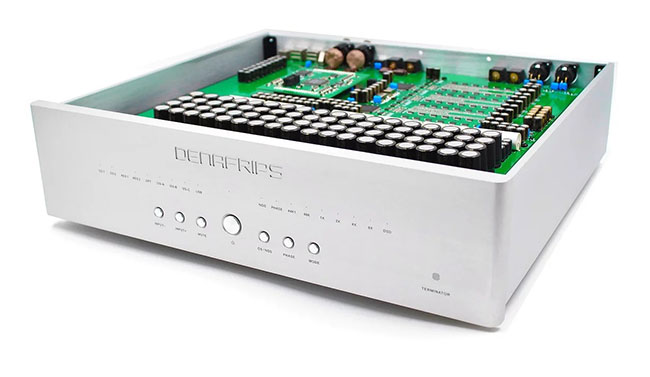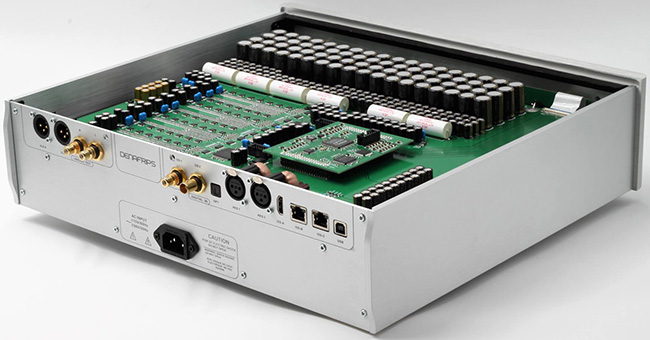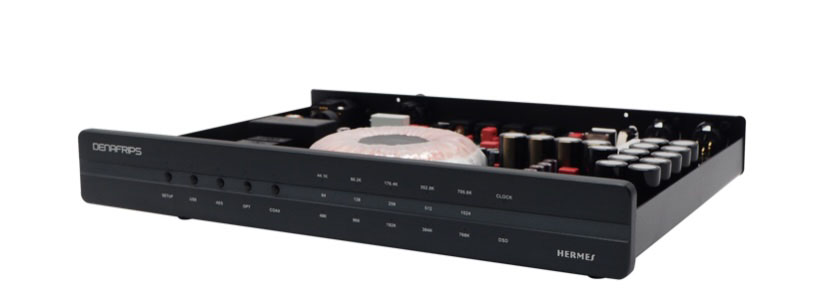Denafrips Terminator II by Richard Willie

 A quality of music reproduction that is often overlooked but that I feel is critical when evaluating a component is whether the reproduced music sounds interesting. The Denafrips Terminator II DAC (herein, Terminator II) has a pure, sonorous, liquid, and natural sound. Still, those adjectives are somewhat lacking in describing the ability of a stereo system to hold the attention of its listener. When used with its sister component, the Hermes (or Gaia) DDC, the Terminator II helps reproduce music in both involving and captivating ways other DACs in my system have not been. Music through this DAC has an effortless quality, can be listened to for days without becoming fatiguing, and has contributed to many satisfying late-night listening sessions. Considering its price point, the Terminator II is a DAC with a level of performance that should merit further consideration for those interested in upgrading their digital audio chain.
A quality of music reproduction that is often overlooked but that I feel is critical when evaluating a component is whether the reproduced music sounds interesting. The Denafrips Terminator II DAC (herein, Terminator II) has a pure, sonorous, liquid, and natural sound. Still, those adjectives are somewhat lacking in describing the ability of a stereo system to hold the attention of its listener. When used with its sister component, the Hermes (or Gaia) DDC, the Terminator II helps reproduce music in both involving and captivating ways other DACs in my system have not been. Music through this DAC has an effortless quality, can be listened to for days without becoming fatiguing, and has contributed to many satisfying late-night listening sessions. Considering its price point, the Terminator II is a DAC with a level of performance that should merit further consideration for those interested in upgrading their digital audio chain.
The Terminator II has a relatively simple design, solid construction, and functionality with performance in mind. Its front fascia is a brushed aluminum with six push-button selectors and LED mode indicators. Notoriously absent is a graphical user interface, volume control, or many of the other frills that frequent many DACs today. Around the back of the unit are an array of digital inputs, including USB, AES/EBU, Coaxial via RCA, Toslink, and I2S. For most of this review, I used the Hermes DDC, which converted a USB input to an I2S output that fed into the Terminator II. While I tested all of the inputs on the Terminator II, I felt that I2S over HDMI was the best-sounding input.
Denafrips seems to have focused its Terminator II development efforts on raw performance. For instance, the power supply consists of two separate transformers (one for the digital and another for the analog sections), with plenty of accompanying filter capacitance. I wonder if the power supply could be more robust than many entry-level power amplifiers! In any case, this attention to quality components, particularly with the robust power supply, is evident in the reproduction of the music, particularly in the bass regions, as discussed below.
A more holistic view of the Terminator II reveals that its heavy focus on performance is likely at the expense of an intuitive user interface. For example, configuring the Terminator II clock to sync to the Hermes DDC clock and figuring out the correct pinout for the I2S connections would have been challenging without constant references to the Terminator II user manual. Configuring the Terminator II as the master clock to the Hermes DDC requires the user to push the mute button, followed by pressing the input selector multiple times, which does not actually change the inputs at all, but rather changes the clock output settings. If syncing to another Denafrips DDC (such as the Hermes DDC), there is a similar unintuitive sequence of buttons to press on the DDC (which are not the same as the Terminator II) to guarantee a good handshake.
Similarly unintuitive, and perhaps the more frustrating part of the setup was the I2S pinout settings between the Denafrips Hermes and the Terminator II. The process is similar to the clock output process above, but this time using the ‘phase’ button instead of the ‘input’ button. The Terminator II has eight possible I2S configurations, but so does the Hermes DDC, and each have to be set correctly to ensure good sound between the two boxes. After carefully reviewing the respective manual and failing to find the correct solution, I moved to a trial and error approach (there are 64 possible combinations). Getting the ‘wrong’ configuration can yield several results ranging from a static sound to phase inversions, swapped channels, or strange-sounding combinations. Some of the ‘wrong’ configurations sound ‘almost’ right, so finding the actual ‘right’ solution was a little time-consuming. Sadly, the manual wasn’t as helpful as I would have liked.
To be fair, these two examples involve integrating a Denafrips DDC into the system; using the Terminator II without a DDC is substantially less complicated. That said, configuration woes aside, once setup is complete, there is little need to change it. The silver lining of a simplified user interface could be considered a strength of this DAC as there are few extraneous components to interfere with producing great sound. Indeed, many may consider the performance of the Terminator II to be well worth the price of admission of a simplified and somewhat unintuitive interface.


Firmware

I experienced a similar issue during my review of the Denafrips Hermes, making the firmware issue with the Terminator II much less alarming. I discussed the issue with Alvin Chee, Vineshine Audio’s owner, and exclusive Denafrips products distributor. He advised me of a new, updated version of the Terminator II firmware that resolved the compatibility problems.
This time a Mac version of the update software was available (instead of just Windows), which was an improvement over my last update experience. However, figuring out how to update the firmware without the Terminator II freezing my Intel Macbook Pro was challenging. It involved updating the Terminator II while it was in standby mode (the ‘off’ position). Once I updated the Terminator II firmware to 3.12, I had no further issues connecting to my Apple computers. I could fully evaluate the Terminator II without the Hermes acting as the intermediary.

Integration with the Hermes DDC
Denafrips is a company that has placed a special product emphasis on the elimination of jitter in the digital audio stream. A couple of months back, I reviewed the Denafrips Hermes (here), which is a Digital-to-Digital converter that receives a digital signal data stream from a source (such as a computer, CD player, etc.), buffers, and re-clocks that data stream, and delivers a resultant signal with significantly mitigated jitter. I used the PS Audio Directstream DAC as my reference in the Hermes review and described the resultant improvement in the sound.
While the Hermes buffers and re-clocks the digital audio stream, it will always be slightly out of synchronization with the internal clock of the PS Audio Directstream DAC. The PS Audio DAC overcomes this misalignment by again buffering the incoming data stream and outputting the same through its VCXO. This buffering acts as another low-pass filter on any incoming jitter. However, because the Hermes and the PS Audio DAC are essentially always slightly out of synchronization, there is some inevitable lost efficiency in the whole process.
The Terminator II and Hermes can operate similarly but have an option for tighter integration. Using two BNC cables (one for each clock frequency), the Terminator II can synchronize the Hermes’s clock to its own and allow the two to act in a much more integrated way. Of the two Terminator II and Hermes configurations, I preferred to have the clocks synced together. Both configurations yielded promising results, but syncing the two clocks together gave more detail and sounded slightly more natural.
While experiments without the Hermes DDC in the audio chain were somewhat limited, a couple of points are worth mentioning. First, the detail-oriented who takes notice of the design specifications of the Terminator II in relation to all the DDCs in Denafrips’s portfolio will realize that the maximum PCM output rate of any Denafrips DDC is 384 kHz. In comparison, the maximum PCM input rate of the Terminator II is 1536 kHz. Therefore, Denafrips’s current line of DDCs represents a resolution bottleneck to the Terminator II/Plus.
Second, the 768 kHz and 1536 kHz resolutions are almost exclusively the province of upsampling since there is very little media existing natively in those formats. In practice, using a Denafrips DDC will only limit the ability to upsample to 16X and 32X resolutions. DDC bottleneck notwithstanding, my experiments with the 768 kHz and 1536 kHz resolutions (upsampled via HQPlayer) led me to believe that I was getting better sound with the Hermes DDC than without.
After reviewing the Hermes DDC with the PS Audio Directstream DAC, I expected an analogous improvement in sound when using the Hermes with the Terminator II. Without the Hermes, the sound of the music coming directly from my computer via USB was not bad, but it was a little more analytical, unrefined, and less organic. The direct USB solution sounded slightly more glassy and edgy in the highs, not quite as articulate in the bass region, and overall less involving. Suffice it to say, I much preferred having the Hermes feed the Terminator II and would encourage anyone looking at the Terminator II to consider a DDC.
Life Without Oversampling
This section of the review has been challenging for me to write simply because my opinion of upsampling has started to change. My early drafts of this section might have easily been titled, ‘upsampling is of the devil.’ However, at this point, what I will say about upsampling is that virtually every permutation of any combination of upsampling I have tried has ended in some level of disappointment. There is often an associated haze, homogenization, and loss of dynamics with upsampling that I dislike. HQPlayer (not reviewed here) has started to change that perception, and I have found at least one combination in the upsampling alchemy that seems pretty decent (poly-sinc-gauss-xla, NS5, 352.8/384 for those curious). I hate it when new facts challenge my worldview!
One of the Terminator II’s claims to fame is its implementation of an R-2R resistor ladder used to convert the digital audio stream to analog form. This design choice has been well documented in many reviews, so that I won’t belabor this review with another technical description of the R-2R ladder. However, what I will point out is how infrequently this design architecture is implemented and how accustomed many listeners have become to the sound of upsampling.
Most of my DACs over the last few years have utilized some upsampling mechanism. For example, my principal point of comparison for this review, the PS Audio Directstream DAC, upsamples all digital audio streams to a DSD audio stream before converting them to an analog signal (even if the audio stream is already DSD). This process is largely responsible for the PS Audio’s analog sound. But, a side-effect of this upsampling is that PCM and DSD recordings sound similar (almost like it’s all DSD!). In comparison, PCM and DSD music through the Terminator II sound more distinct and differentiated than I was used to with the PS Audio. While upsampling can be added back into the music via Roon or HQPlayer, I preferred the sound of an unmodified PCM audio stream for most of the review period. In all honesty, the change has been a breath of fresh air.
Listening

The listening sessions are where the Terminator II shines. Despite the ominous naming convention, the Terminator II is articulate, detailed, full-bodied, and, above all, natural. A couple of qualities merit further discussion. The bass of the Terminator II is deep and articulate, punchy, and fills out the sound. Each note seems to have a “meat on the bones” quality without crossing the line of being artificial. Kick drums have impact and depth, and the bass tends to be full, grounded, and earthy. In fact, my notes are replete with comments about the bass and its increased texture and resolution. For a large portion of the review period, I turned off my Tekton Design 4-10 subwoofers because I was enjoying the bass from the loudspeakers themselves.
The next standout quality of the Terminator II is the detail and holographic nature of the sound. The mids and high frequencies have a crisp neutrality that is both clear and involving, not romantic or warm, but at the same time, not overly analytical. The timbre and color of tone are excellent, making different instruments much easier to distinguish from one another. Unaccompanied piano sounds natural, realistic, and beautiful. Cymbals have sizzle, air, and shimmer around them that is revealing. In a word, this DAC sounds “pure.”
The Marc Vallée Trio’s “Hamadryade,” released by Fidelio Audio, is an album that I consistently use to evaluate system components (whether I specifically mention it in the review or not.) I frequently revisit this album for the detail, colors, richness, depth, sense of space, and utilization of the full frequency spectrum. The title track, “Hamadryade,” really exhibits how well the Terminator II reproduces various tones and colors while expertly depicting all of the qualities I love about this album. Purity and liquidity are the adjectives that come to mind when listening to this album and this track.
 John Mayer’s “Sob Rock,” released by Columbia Records, is an album that draws inspiration from the Pop and Rock of the mid-1980s (the music video even pokes a bit of fun at 80’s music videos). Wild Blue is one of my favorite tracks on the album, and it caught me off guard the first time I heard it. Although I was fully aware I was listening to a John Mayer record, this track had me genuinely wondering if Mark Knopfler was making a guest appearance. A couple of Google searches revealed that wasn’t the case, but what an homage to one of the greats. Overall, Wild Blue comes off as relaxed and rich sounding, with great dynamics in true Dire Straits fashion.
John Mayer’s “Sob Rock,” released by Columbia Records, is an album that draws inspiration from the Pop and Rock of the mid-1980s (the music video even pokes a bit of fun at 80’s music videos). Wild Blue is one of my favorite tracks on the album, and it caught me off guard the first time I heard it. Although I was fully aware I was listening to a John Mayer record, this track had me genuinely wondering if Mark Knopfler was making a guest appearance. A couple of Google searches revealed that wasn’t the case, but what an homage to one of the greats. Overall, Wild Blue comes off as relaxed and rich sounding, with great dynamics in true Dire Straits fashion.
Speaking of the ’80s… “Simulation Theory” by Muse and released by Warner Records is another album calling back to that era, only in a more Orwellian/Blade Runner way. The album’s opener is a dark and complex track, with a deep pulsing beat that lays the foundation. Synthesizers build a framework on top of that foundation and drive the music forward with urgency. If I had to sum this track up in a single word: busy. Many things are going on, and the Terminator II helps unravel all of those beautifully. Nearly a minute into the track’s intro, a series of piano progressions break the electronic background music in a way that the Terminator II renders realistically while still bringing out the trailing decays between each progression amid all of the background complexity. The Terminator II sets the stage with deep taught bass while putting space between the different layers of music that I hadn’t heard before.
Of all the sound characteristics at play, one of the most important to me is the ability to render music not only in a way that is not fatiguing but interesting. The Terminator II helped do this to a greater degree than many other DACs in my system. The ability to hold my interest in music is something I hold as an essential characteristic of an excellent stereo component, and the Terminator II seems to do it very well.
Comparison
 The PS Audio DirectStream DAC has been my reference for the past couple of years. The Directstream DAC is known for its smooth, relaxed, vinyl-like sound and has been well documented by reviewers and forum users. One of the interesting things about the Directstream DAC was its almost annual firmware upgrades that steadily improved the sound with each iteration. However, with PS Audio’s final firmware release for the DirectStream DAC (named “Sunlight”), this DAC reached full maturity (hopefully making the comparison a bit more meaningful).
The PS Audio DirectStream DAC has been my reference for the past couple of years. The Directstream DAC is known for its smooth, relaxed, vinyl-like sound and has been well documented by reviewers and forum users. One of the interesting things about the Directstream DAC was its almost annual firmware upgrades that steadily improved the sound with each iteration. However, with PS Audio’s final firmware release for the DirectStream DAC (named “Sunlight”), this DAC reached full maturity (hopefully making the comparison a bit more meaningful).
The Denafrips Terminator II is distinguishable from the PS Audio Directstream DAC in several ways. A few things stand out when switching from the Directstream DAC to the Terminator II. First, the ends of the frequency spectrum are somewhat extended in comparison; bass digs deep and is more guttural, taut, and resolved. Similarly, the highs are extended with sparkle and shimmer, resolving a higher level of detail. Even though the Directstream DAC still has that sense of relaxed analog warmth, the Terminator II has a greater sense of a naturalness and purity (which, paradoxically, was the case with both PCM and DSD audio streams).
Switching from the Terminator II back to the Directstream DAC reveals additional differences. The Directstream DAC has a light and airy quality throughout the entire range, with a touch of sweetness on the upper midrange that is especially noticeable on female vocals. The PS Audio Directstream has a very ‘nice’ sounding quality on the mids and highs that I enjoy. In comparison, the Terminator II does sound a little more “matter of fact” and less romantic.
The user interface and experience between these two manufacturers are different as well. The Denafrips has been somewhat quirky in its operation compared to the PS Audio. For instance, the initial Denafrips firmware would freeze my Apple computers as soon as they were connected via USB before the update was installed; there is an occasional ‘pop’ when switching DSD rates (between DSD128 and DSD256) on an infrequent[1] basis the digital audio stream on the Denafrips seems to get “out of sync” with the Hermes producing a very obvious and obnoxious metallic sound[2] (which is remedied by pausing and restarting the music). The use of the user manual is a necessity when setting up or changing the system.
The Directstream DAC has more bells and whistles and a friendlier user experience. For instance, it has an internal volume control (which doesn’t appear to impact the sound quality), it can be used without a preamp, its firmware updates could be installed remotely without user intervention via a connected ethernet port, and it doesn’t suffer from occasional clicks and pops switching rates. Perhaps most notably, the UI was intuitive enough that referencing the user manual was seldom required. In short, the PS Audio Directstream DAC has a much more polished and smooth user experience. These are both great DACs with different flavors of reproducing music. What each listener prefers may understandably come down to taste and system synergy, and I could see users being happy with either.
Conclusion
The Denafrips Terminator II is an excellent performer with a natural and pure sound, which is articulate and extended at both ends of the frequency spectrums. I get the sense its development was skewed in favor of raw performance rather than the user interface. I am not the type to shrink from a technical challenge and did not necessarily hate having to jump into the user manual to figure out how this piece of equipment worked, though I could imagine some users wishing that the user experience was a little more intuitive. However, this is a single-purpose DAC with a “set it and forget it” type functionality. Once it is up and running, there is typically little to do regarding settings. Ultimately, the sound quality of the Denafrips was outstanding, and its focus on performance won me over. Actions speak louder than words, so let me end with this: I purchased the review sample.
Richard Willie

Price
- S$6149, which must be converted to USD.
- $4,396.24 USD at time of writing.
Specifications:
- Proprietary R2R + DSD Architecture
- True balanced 26BIT R2R + 6BIT DSD (32 steps FIR Filters)
- Matched Precision Thin Film 0.005% R-2R Network Arrays
- Encapsulated Flagship Ultra Low Noise Power Supply
- Oven Controlled Crystals OCXO
- Adaptive FIFO Buffer Reclocking
- New Improved Digital Signal Processing FPGA Code
- DSD1024, PCM1536 Supports On USB & I²S Input
- Proprietary USB Audio Solution via STM32F446 Advanced AMR Based MCU
- Licensed Thesycon USB Driver For Windows Platform
- Driverless On Mac & Linux
- Dual AES/EBU Input Supports
- Sharp/Slow Filters Option
- I²S Pinout Configuration
- I²S DSD Channel Swap Configuration
DSD
- DSD64 (DoP) on Coax/AES/Opt Input
- DSD1024* On USB & I²S Input Only
PCM
- 24bits / 44.1, 48, 88.2, 96, 176.4, 192KHz On All Input
- 1536kHz* On USB & I²S Input
Sampling Mode: Non-Oversampling NOS / Oversampling OS
Digital Input
- Coax via RCA
- TOSLink x 1
- AES/EBU x 2
- USB2.0 Type B
- I²S via HDMI LVDS
- I²S via RJ45 LVDS
- I²S via RJ45 LVCMOS
Analog Output
- RCA at 2.0Vrms, 625 Ω
- XLR at 4.0Vrms, 1250 Ω
Clock Output BNC 75Ω
- 44.1KHz, 48KHz
- 22.5774Mhz, 24.576Mhz
- 45.1548MHz, 49.152Mhz
Frequency Response: 20-40KHz -0.2dB
THD+N: 0.0015%
S/N Ratio: 127dB
Dynamic Range: >132dB
Stereo Crosstalk: -110dB
AC Power Requirement: 100-240VAC, 50/60Hz (Worldwide Voltage)
Power Consumption: ≤20W
Dimension: 430W x 380D x 125H mm (Includes Footers)
Package Dim: 610 x 570 x 275 mm
Package Content: DAC only. No power cord & remote control.
Weight: 19.0 Kg
Color: Silver / Black
Warranty: 36 Months
Website: https://www.denafrips.com/
[1] By “infrequently,” I mean perhaps once per week of listening or less.
[2] Curiously, I have only noticed this occur with a USB connection to the Hermes. Other connections did not seem to be impacted. Additionally, I have an iFi USB Purifier 2 that I have at times put into the audio chain when doing sound comparisons. I don’t recall this ever occurring with the iFi USB Purifier in the audio chain, though it is possible that I never had the iFi purifier in for a long enough duration to experience the error.
Stereo Times Masthead
Publisher/Founder
Clement Perry
Editor
Dave Thomas
Senior Editors
Frank Alles, Mike Girardi, Russell Lichter, Terry London, Moreno Mitchell, Paul Szabady, Bill Wells, Mike Wright, and Stephen Yan,
Current Contributors
David Abramson, Tim Barrall, Dave Allison, Ron Cook, Lewis Dardick, John Hoffman, Dan Secula, Don Shaulis, Greg Simmons, Eric Teh, Greg Voth, Richard Willie, Ed Van Winkle, Rob Dockery, Richard Doran, and Daveed Turek
Site Management Clement Perry
Ad Designer: Martin Perry








Be the first to comment on: Denafrips Terminator II by Richard Willie